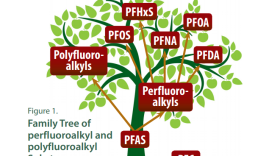Three schools in the Hudson Valley have “Do Not Drink” advisories after two PFAS chemicals were found above New York state’s contamination limits. These are among the first schools with the higher levels since the state adopted new maximum contaminant levels for PFOA and PFOS over the summer.
The New York state Department of Health along with the respective county health departments, recommended the advisories for two elementary schools in northern Westchester County and a middle/high school in Dutchess County. The state’s maximum contaminant level, or MCL, for PFOA is 10 parts per trillion; the same for PFOS State DOH spokesman Gary Holmes says locales with smaller water systems, such as these school districts, were to have begun water testing under the new MCLs in February.
“And so in these instances, with these particular school districts, you’re talking smaller water systems. They did what they were supposed to do — follow and adhere to the MCL process, and that brings us to where we are today,” Holmes says. “Let’s put a plan in place here that gets these systems back under these levels, these highly protective levels that we set here in New York state.”
He says DOH issued the “Do Not Drink” advisories because it felt the levels at the three schools warranted such.
“It’s what we believe is a prudent measure to protect public health,” says Holmes. “It’s a short-term measure while we work towards a long-term measure.”
In Dover Plains, Dutchess County, Holmes says the presence of three PFAS chemicals, two above the state’s MCLs, led to the advisory for the Dover Middle/High School.
“So PFOS around 20 parts per trillion; PFOA was around 60 parts per trillion,” says Holmes. “And in particular with the Dover School District here, it was the, the reason we took the ‘Do Not Drink’ advisory step, because it was largely based on the factors that we found PFOA, PFOS and detections of PFHxA, which I should point out is a contaminant that currently does not have an MCL, but it does have similar properties to the other PFAS compounds that we discovered.”
Superintendent of the Dover Union Free School District Mike Tierney says the school’s water fountain has been shut off and is being replaced with bottled water until a fix is in place. He says the water at the elementary schools is safe and not part of this testing process.
The state DOH recommended “Do Not Drink” advisories for two elementary schools in Westchester County — Pequenakonck Elementary School in North Salem and Meadow Pond Elementary in South Salem. The advisories direct the schools to stop using water for drinking, cooking and food preparation. Holmes says Meadow Pond has been equipped with bottled water since October 2018.
“We learned in speaking directly to school officials that that school has actually been on bottled water for upwards of two years for an unrelated water quality matter,” Holmes says.
That unrelated matter pertains to high levels of chloride and uranium found in the well water that the district continues to work toward remedying. Holmes says Meadow Pond’s PFOS levels were in the low 100s and twice this level for PFOA. A statement sent to WAMC from the Katonah-Lewisboro School District says because the school was already using bottled water, the new advisory will not have any significant impact. With the March 16 advisory, the statement says that although the school was already using bottled water in the preparation of food, officials must install a carbon filter on the faucet that supplies all water in the kitchen. School officials have checked to ensure that signs are prominently posted at all faucets to remind students and staff not to drink the water that continues to be safe and in use for handwashing and flushing toilets.
The state Department of Environmental Conservation is investigating, with no apparent sources the culprit as of yet. DEC Chief of Staff Sean Mahar:
“DEC is working closely with our partners at the state Department of Health to identify all potential sources of PFAS contamination and, if found, assess the full nature and extent of that contamination in the community,” says Mahar. “If detected, DEC’s experts will implement strategies to mitigate that contamination, and we will keep the community informed every step of the way as our efforts advance.”
The U.S. Environmental Protection Agency has an advisory level for PFOA and PFOS of 70 parts per trillion each. Holmes says water at Pequenakonck Elementary in North Salem contained PFOA levels in the high 70s/low 80s, and that PFOS was not of concern. Rob Hayes is Director of Clean Water at Environmental Advocates NY.
“We are glad that the Department of Health is taking a precautionary approach to this contamination. There is no known safe level of PFAS in drinking water. The state should be taking every possible action to prevent exposure among the most vulnerable population, like children,” Hayes says. “Now, the state needs to be fully transparent about the extent of PFAS contamination in these schools’ water. How many PFAS chemicals were detected, and at what levels? Parents, kids, teachers, they deserve to know that information.”
Holmes says some school districts have restricted water use already because of the COVID-19 pandemic.
“Some of the COVID restrictions at these school districts here, many of these school districts have really kind of discontinued the use of the water, the bubblers, the water fountains, as a COVID protocol anyway,” Holmes says.
Because of this, he says administrators in the district can quickly address the “Do Not Drink” advisory. DOH says the advisories were issued out of an abundance of caution.









